Experimentation is the third Internal Attribute in the IDEAS acronym. In Chapter 4 of Exponential Organizations you can read more about this and I suggest taking a look at the open source tool developed by the ExO Ecosystem. Also take a look at Exponential Transformation where you can learn about implementing Exponential Attributes in your current organisation.
Building a culture of experimentation is something that all companies should be striving towards. We have all heard the credo fail fast, fail forward. Silicon Valley was built on good failure and many business leaders have indicated that the ability to experiment and learn from failure is vital to their success. As John Seely Brown indicated in a commencement speech given at Singapore Management University, corporate architecture is setup to withstand risk and change and to scale efficiently and predictably, meaning that they create rather static environments. This is a very dangerous environment as it is prone to disruption from smaller more agile organisations that are using experimentation through the Lean approach together with Design Thinking.
I have taken the Lean Startup and Design Thinking approaches and combined them to create a model for experimentation to be built into an organisation culture. The Lean Startup Principles are:
- Entrepreneurs are Everywhere
- Entrepreneurship is Management
- Validated Learning
- Innovation Accounting
- Build-measure-learn Process
The Design Thinking Principles are:
- Human Centered
- Mindful of Process
- Culture of Prototyping
- Bias Toward Action
- Show Don’t Tell
- Radical Collaboration
So if you want to build a culture of experimentation in your organisation you need to understand these principles and implement them, the diagram below has taken the two frameworks and combined them into one. (The Lean Framework is here and the Design Thinking framework here)

Exponential Transformation outlines six steps to implement experimentation:
- Educate your team and align incentives
- Define your hypothesis and value proposition
- Build and execute experiments to evaluate your hypothesis
- Gather and analyse data from the results of the experiments
- Learn from the data
- Iterate your Approach
These six steps are essentially outlined in the above diagram. It is vital that the approach is data driven and scientific in nature rather than through intuition. It is time to start experimenting. If you start with ensuring that people understand the experimental culture and start with small things you will be able to get on the road to building a culture where experimentation is acceptable and therefore you can become the disruptor rather than being disrupted.

Recent Comments